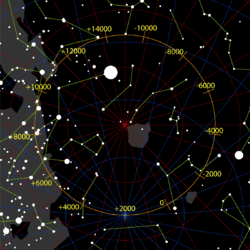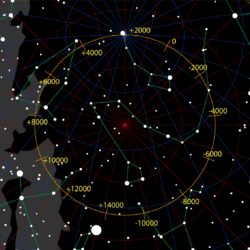- Pole star
-
For other uses, see Polestar (disambiguation).
- "North Star" redirects here. For other uses, see North Star (disambiguation).
The term "Pole Star" usually refers to Polaris, which is the current northern pole star, also known as the North Star.
In general, however, a pole star is a visible star, especially a prominent one, that is approximately aligned with the Earth's axis of rotation; that is, a star whose apparent position is close to one of the celestial poles, and which lies approximately directly overhead when viewed from the Earth's North Pole or South Pole. A similar concept also applies to other planets.
The south celestial pole currently lacks a bright star like Polaris to mark its position. At present, the naked-eye star nearest to this imaginary point is the faint Sigma Octantis, which is sometimes known as the South Star.
While other stars' apparent positions in the sky change throughout the night, as they appear to rotate around the celestial poles, pole stars' apparent positions remain essentially fixed. This makes them especially useful in celestial navigation: they are a dependable indicator of the direction toward the respective geographic pole, and their angle of elevation can also be used to determine latitude.
The identity of the pole stars gradually changes over time because the celestial poles exhibit a slow continuous drift through the star field. The primary reason for this is the precession of the Earth's rotational axis, which causes its orientation to change over time. If the stars were fixed in space, precession would cause the celestial poles to trace out imaginary circles on the celestial sphere approximately once every 26,000 years, passing close to different stars at different times. However, the stars themselves exhibit motion relative to each other, and this so-called proper motion is another cause of the apparent drift of pole stars.
Contents
Northern pole star (North Star)
Time-lapse video of Polaris and neighboring stars.
 A long exposure photo of Polaris and neighbouring stars, taken from East Anglia in the United Kingdom during September 2010. Polaris can be seen, static, in the upper left corner.
A long exposure photo of Polaris and neighbouring stars, taken from East Anglia in the United Kingdom during September 2010. Polaris can be seen, static, in the upper left corner.
At the present time, the northern pole star, or North Star, is Polaris, which lies about one degree from the north celestial pole, at the end of the "bob" or "handle" of the Little Dipper asterism in the constellation Ursa Minor.[1] A common method of locating Polaris in the sky is to follow along the line of the so-called "pointer" stars in the bowl of the Big Dipper asterism, specifically, the two stars farthest from its "handle". The arc between the pointer stars & Polaris is nearly five times greater than the arc between the pointer stars.[2]
Polaris is a moderately bright star with an apparent magnitude of 1.97 (variable) making it the brightest star in the Little Dipper. Its current declination is +89°15'50.8".
The North Star has historically been used for navigation, both to find the direction of north and to determine latitude. It always appears due north in the sky, and the angle it makes with respect to the horizon is equal to the latitude of the observer. The North Star can be seen slightly south of the Equator (because of atmospheric refraction); further south, it cannot be used for navigation.
Past and future
Due to the precession of the equinoxes (as well as the stars' proper motions), the role of North Star passes from one star to another. Since the precession of the equinoxes is so slow, taking about 25,770 years to complete a cycle, a single star typically holds that title for many centuries.
Polaris' mean position (taking account of precession and proper motion) will reach a maximum declination of +89°32'23", so 1657" or 0.4603° from the celestial north pole, in February 2102. Its maximum apparent declination (taking account of nutation and aberration) will be +89°32'50.62", so 1629" or 0.4526° from the celestial north pole, on 24 March 2100.[3]
Gamma Cephei (also known as Alrai, situated 45 light-years away) will become closer to the northern celestial pole than Polaris around AD 3000. Iota Cephei will become the pole star some time around AD 5200.
First-magnitude Deneb will be within 5° of the North Pole in AD 10000.
The brilliant Vega in the constellation Lyra is often touted as the best North Star (it fulfilled that role around 12000 BC and will do so again around the year AD 14000). However, it never comes closer than 5° to the pole.
When Polaris becomes the North Star again around 27800 AD, due to its proper motion it then will be farther away from the pole than it is now, while in 23600 BC it came closer to the pole.
In 3000 BC the faint star Thuban in the constellation Draco was the North Star. At magnitude 3.67 (fourth magnitude) it is only one-fifth as bright as Polaris, and today it is invisible in light-polluted urban skies.
Southern pole star (South Star)
Currently, there is no South Star as useful as Polaris. Sigma Octantis is the naked-eye star closest to the south Celestial pole, but at apparent magnitude 5.45 it is too faint to serve as a useful pole star. Its angular separation from the pole is about 1° (as of 2000[update]). The Southern Cross constellation functions as an approximate southern pole constellation, by pointing to where a southern pole star would be. At the equator it is possible to see both Polaris and the Southern Cross.
Past and future
 The path of the south Celestial pole amongst the stars due to the effect of precession[clarification needed]
The path of the south Celestial pole amongst the stars due to the effect of precession[clarification needed]
Although the south Celestial pole currently lacks a bright star like Polaris to mark its position, slow changes over time (due to the effects of precession) mean that other stars will become southern pole stars.
The Celestial south pole is moving toward the Southern Cross, which has pointed to the south pole for the last 2,000 years or so. As a consequence, the constellation is no longer visible from subtropical northern latitudes, as it was in the time of the ancient Greeks.
There have been many pole stars throughout the millennia. Around 2000 BC, the star Eta Hydri was the nearest bright star to the Celestial south pole.
In the next 7500 years, the south Celestial pole will pass close to the stars Gamma Chamaeleontis (4200 AD), I Carinae, Omega Carinae (5800 AD), Upsilon Carinae, Iota Carinae (Aspidiske, 8100 AD) and Delta Velorum (9200 AD).[4] From the eightieth to the ninetieth centuries, the south Celestial pole will travel through the False Cross.
Other planets
Pole stars of other planets are defined analogously: they are stars that most closely coincide with the projection of the planet's axis of rotation onto the Celestial sphere. Different planets have different pole stars because their axes are oriented differently. (See Poles of astronomical bodies.)
- Alpha Pictoris is the south pole star of Mercury, while Omicron Draconis is the north star.[5]
- Phi Draconis is the closest star to the southern pole of Venus, however Eta¹ Doradus is brighter though not as close.
- Delta Doradus is the south pole star of the Moon.
- Kappa Velorum is only a couple of degrees from the south Celestial pole of Mars. The top two stars in the Northern Cross, Sadr and Deneb, point to the north Celestial pole of Mars.[6]
- Delta Octantis is the south pole star of Saturn.
- Eta Ophiuchi is the north pole star of Uranus and 15 Orionis is its south pole star.
- The north pole of Neptune points to a spot midway between Gamma and Delta Cygni. Its south pole star is Gamma Velorum.
Some asteroids have more than one axis of rotation, possible due to impacts with other bodies. These asteroids tumble in space and have no pole stars. It is possible that a planet could be similarly affected, though unlikely as the much greater mass of a planet and its (usually) spherical shape make it much more unlikely for an impact to create a second axis of rotation.
In world cultures
In Japan the Pole Star was represented by Myouken Bosatsu, ja:妙見菩薩.
In the Greek Magical Papyri the Pole star was identified with Set-Typhon, and given authority over the Gods.
See also
References
- ^ van Leeuwen, F. (2007). "HIP 11767". Hipparcos, the New Reduction. http://webviz.u-strasbg.fr/viz-bin/VizieR-5?-out.add=.&-source=I/311/hip2&recno=11739. Retrieved 2011-03-01.
- ^ http://www-istp.gsfc.nasa.gov/stargaze/Spolaris.htm
- ^ Jean Meeus, Mathematical Astronomy Morsels Ch.50; Willmann-Bell 1997
- ^ http://myweb.tiscali.co.uk/moonkmft/Articles/Precession.html
- ^ 2004. Starry Night Pro, Version 5.8.4. Imaginova. ISBN 978-0-07-333666-4. www.starrynight.com
- ^ http://www.eknent.com/etc/mars_np.png
External links
Categories:- Navigation
- Stars
- Pole stars
Wikimedia Foundation. 2010.


